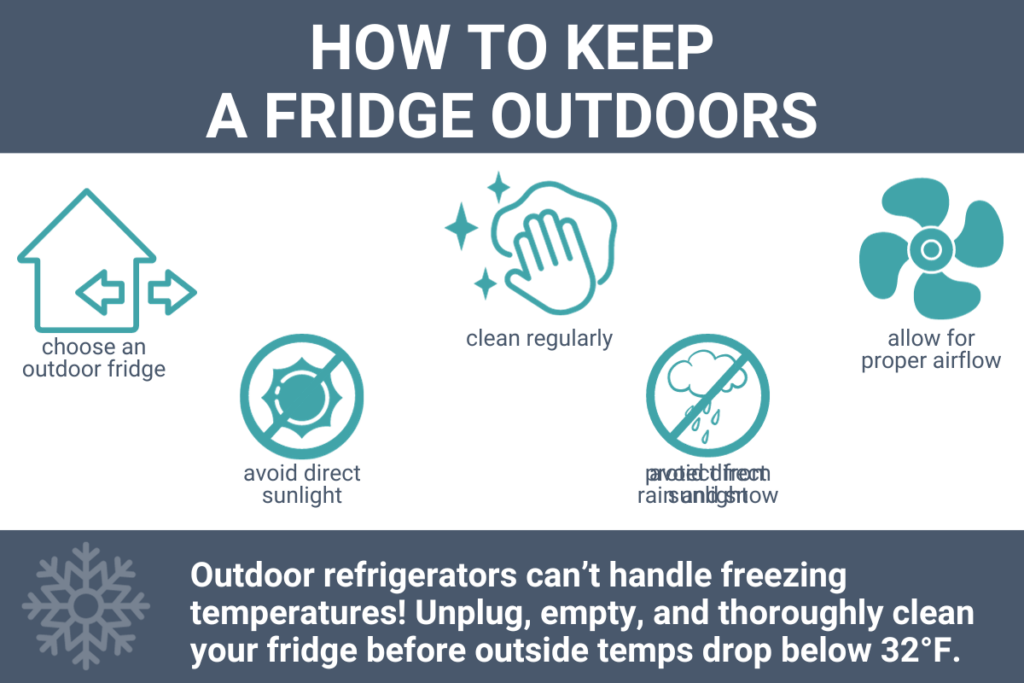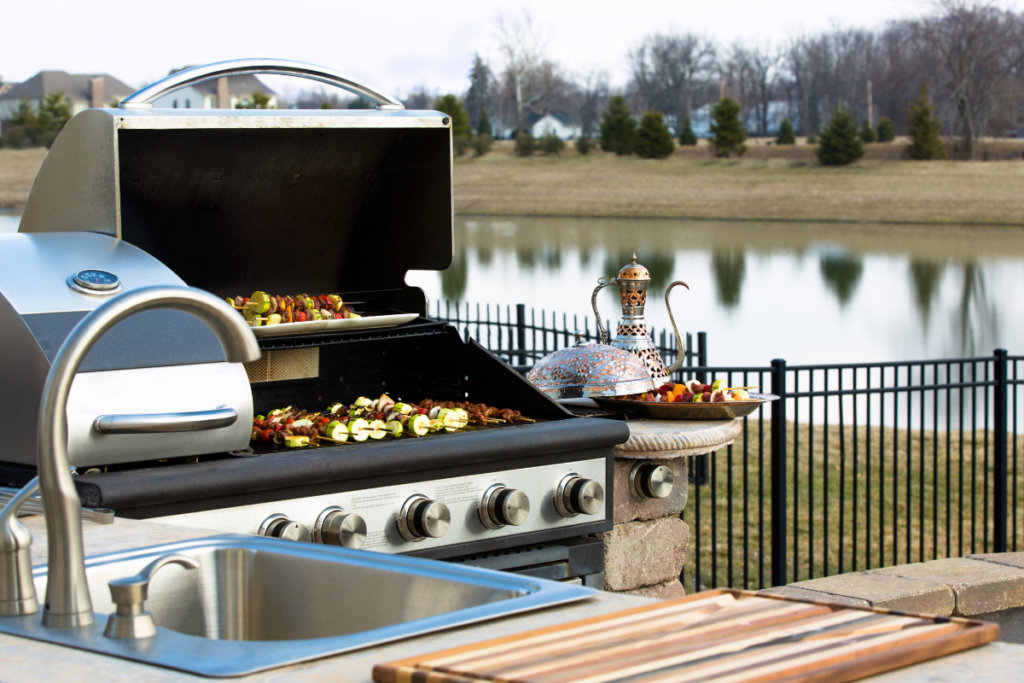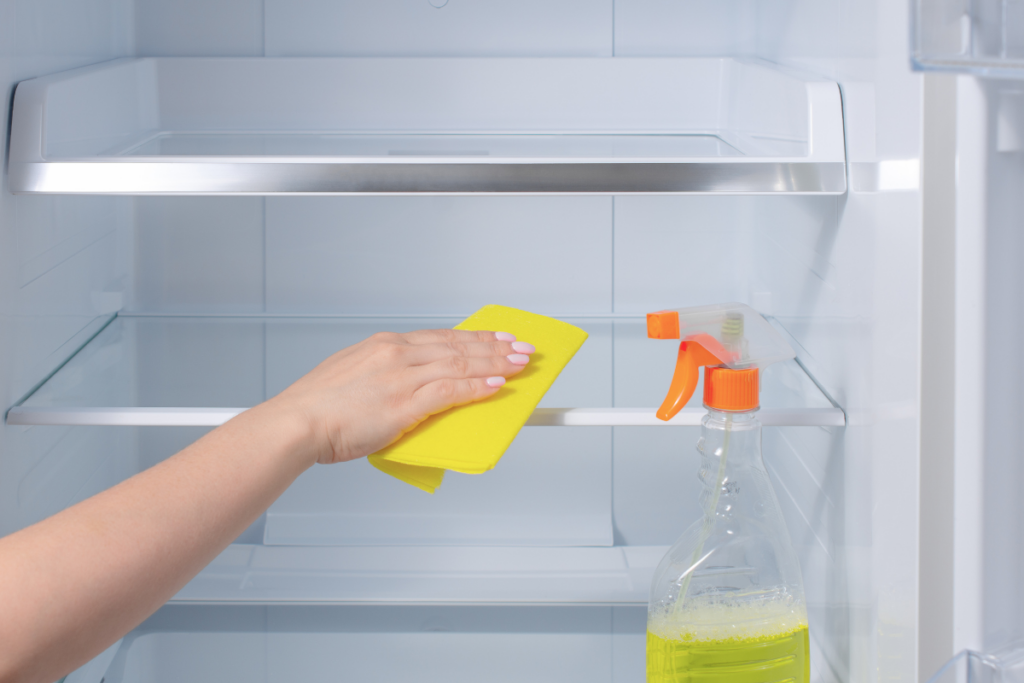How to Keep a Fridge Outside [Plus How to Prepare It for Winter]
In the last several years, people have embraced staying home and, in turn, making their homes as comfortable and luxurious as possible. With bedrooms, bathrooms, and kitchens having already experienced the HGTV boom, many people have turned their attention to the exterior. While outdoor cooking used to take place on a bare back patio using a relatively simple grill, the ideal outdoor cooking space is now a full-blown exterior kitchen with multiple cooking surfaces, cabinets, a sink, and even refrigeration. If you’re considering putting in an outdoor kitchen, you’re probably wondering how to keep a fridge outside.
A refrigerator designed specifically for outdoor use is the best option when using an outside fridge. It should be protected from direct exposure to the elements, have adequate airflow, and undergo regular maintenance. An indoor refrigerator should not be used outside as ambient temperatures below 60°F and above 95°F can damage the appliance.
Keep reading for all the reasons you shouldn’t move your kitchen refrigerator outside, and the differences between indoor and outdoor refrigerators.
Can a refrigerator be kept outside?
Whether you’re adding a cabana by the outdoor pool or considering an exterior kitchen to add room for hosting and help keep the house cool during the summer, having a refrigerator at hand can improve the atmosphere and convenience of your new oasis. Is it possible to keep a fridge outdoors?

You should not keep an indoor refrigerator outdoors. However, you can purchase an outdoor refrigerator that has been built to withstand limited exposure to wind, rain, and the sun.
These outdoor refrigerators are able to function at temperatures outside of the range of normal refrigerators.
5 tips for how to keep your fridge outside
Once you’ve decided you’re going to keep your refrigerator outside, there are a handful of basic precautions you should take to ensure you get the best results and the longest life out of your new fridge.

To keep your fridge outside, you should:
- Use an outdoor refrigerator
- Allow proper space for airflow
- Shield your refrigerator from the sun
- Protect your refrigerator from direct exposure to precipitation
- Perform regular cleaning and maintenance
Let’s check out these tips in greater detail.
Use an outdoor refrigerator
Most refrigerators function best in a relatively protected environment, the kind that you’d find in most kitchens.
Outdoor fridges feature weatherproofed electrical components, additional insulation, rust-resistant exterior materials, and compressors that are able to function in a much wider range of ambient temperatures than indoor refrigerators.

Indoor fridges may work for a limited time in mild weather, but they won’t be able to handle exposure to the elements or more extreme temperatures.
Allow proper space for airflow
Despite being appropriate for exterior use, outdoor refrigerators should be stored under a counter for protection from the sun rain, hail, and snow.
Leave 2-3 inches between the back of the unit and the wall and about an inch on the top and sides to allow for proper ventilation.
This is one thing that indoor and outdoor refrigerators have in common!
While you’re considering where to put your outdoor fridge, you may also want to take a look at the typical electrical requirements for a mini fridge.
Shield your refrigerator from the Sun
Installing your outdoor refrigerator under a counter will help protect it from overheating when in direct sunlight.
Your outdoor refrigerator should not be kept in direct sunlight. Instead, keep it under an awning, in a shed (such as a cabana), or under a counter. Direct sunlight will cause the unit to heat up past the day’s temperature.
When planning your under-counter installation, make sure that the exposed front of the refrigerator is never in the direct path of the sun’s rays.
Protect your refrigerator from direct exposure to precipitation
While planning how to minimize your outdoor fridge’s exposure to sunlight, you also need to take into consideration rainfall, sleet/snow, and hail.
Your outdoor refrigerator should be located so that it is not directly exposed to precipitation. While the electrical components are weatherproofed, the fridge can still be damaged by too much moisture.
Placing your refrigerator under a cabinet or against the back of a shed/cabana should do the trick.
Perform regular cleaning and maintenance
As with most appliances, regular cleaning and maintenance will help extend the life of your outside refrigerator.

You should clean your outside refrigerator by wiping down the top and exterior regularly, but you will also need to conduct annual maintenance at the end of each season:
- Empty your refrigerator – Remove all food and drinks and transfer them to a kitchen or garage refrigerator.
- Unplug your refrigerator – While the fridge is pulled out, take the time to sweep behind it and vacuum the exterior vents.
- Thoroughly clean your refrigerator – Any food or debris that is left in the fridge with the power off will be a smelly mess when it’s time to turn it back on.
- Shut off any connected water – If your fridge is connected to a water line, it should be turned off at the valve, disconnected, and drained. Any water left in the pipes may expand and cause the pipes to burst come winter.
All annual maintenance should be conducted before the outside temperature drops below freezing.
What is the difference between an indoor refrigerator and an outdoor refrigerator?
When purchasing a new refrigerator earlier this year, I looked into energy efficiency, interior space, overall size, and the pros and cons of different freezer configurations. One thing I never considered was what room temperature it might need to function. Thankfully I was buying a refrigerator for my kitchen and looking for something to go outside!
Indoor and outdoor refrigerators may serve the same basic function – keeping food and beverages cool – but outdoor refrigerators have several features on top of those you’d expect from a basic indoor fridge, including:
- Enhanced insulation – Manufacturers equip outdoor refrigerators with more insulation than their standard counterparts to help keep the internal temperature down.
- Weatherproofing – Outdoor refrigerators are able to withstand limited exposure to rain and humid conditions because the electrical components are weatherproofed.
- Rust resistant – Outdoor refrigerators are typically made of high-quality stainless steel which is durable and unlikely to rust when maintained properly.
- Compressor – The compressor in an outdoor refrigerator is designed to handle the stresses of cooling up to 100°F.
Additionally, outdoor refrigerators are not generally intended for long-term storage. Rather, they tend to be on the smaller size and are best for holding food that is going to be served immediately and beverages.
Can you put an indoor refrigerator outside?
Indoor refrigerators should not be kept outside.
Indoor refrigerators are designed to work within a limited temperature range and are not intended to be exposed to rain, wind, or other environmental elements. An indoor refrigerator that is used outside won’t last long due to overheating, rust, or getting water in its motor.
Indoor refrigerators work best at an ambient temperature of at least 60°F. Most indoor refrigerators will be unable to maintain their internal temperature once the ambient temperature gets above 90°F.
Top tip: Since most people never move their refrigerator out of the kitchen, it’s worth checking your owner’s manual for your model’s ideal ambient temperature range. Chances are it’ll work in your garage, but not outside.
Do you need a special refrigerator for outdoors?
If you will be keeping your refrigerator outdoors for any length of time, you should invest in an outdoor refrigerator.
Outdoor refrigerators have additional design features that allow them to function with limited exposure to the elements including insulation, weatherproofing, enhanced rust resistance, and a compressor that can withstand the additional rigors of a wider range of ambient temperatures.
However, it’s worth remembering that outdoor refrigerators can still be damaged by extreme weather conditions and should not be used in temperatures outside of 40-100°F.
Since 40°F is the recommended temperature for refrigerators, a lower ambient temperature will cause the internal temperature of the fridge to drop, potentially into freezing. On the other hand, temperatures exceeding 100°F may cause damage to the cooling system.
Summary of how to keep a fridge outside
Indoor refrigerators should not be kept outside.
An outside refrigerator can be used under the following conditions:
- It is kept in a covered shelter or under a counter and protected from the sun and precipitation.
- There are 2-3 inches between the unit and the wall and an inch is allowed on the top and sides to allow for proper ventilation.
- It is not used when the outside temperature exceeds 100°F.
- It is prepared for winter and not used when the outside temperature does not exceed 32°F.
Why are outdoor refrigerators so expensive?
Outdoor refrigerators are more expensive than comparable indoor refrigerators because of the additional weatherproofing and insulation required and the more advanced compressor required to work in a wider ambient temperature range.
Can you leave an outdoor refrigerator outside in the winter?
It is safe to leave an outdoor refrigerator outside in the winter, although you should unplug and winterize it first.
Can you leave an outdoor refrigerator on in the winter?
You should not leave an outdoor refrigerator on in the winter.
Once the outside temperature drops below 32°F, you should unplug the fridge and perform the recommended annual maintenance.
Can you put a mini fridge outside in summer?
Indoor mini fridges should not be kept outside in the summer. Instead, consider purchasing a mini fridge that has been rated for outdoor use.
Let Us Know How We’re Doing!
Did this expertly prepared resource answer your question?
Do you have another question about home maintenance, home improvement projects, home appliance repair, or something else?
Get more information, send in questions and keep the discussion going by contacting the I’ll Just Fix It Myself company customer service team at at 1-800-928-1490 or Email us at [email protected]
